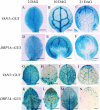DRP1A is responsible for vascular continuity synergistically working with VAN3 in Arabidopsis
- PMID: 15923323
- PMCID: PMC1150399
- DOI: 10.1104/pp.105.061689
DRP1A is responsible for vascular continuity synergistically working with VAN3 in Arabidopsis
Abstract
In most dicotyledonous plants, vascular tissues in the leaf have a reticulate venation pattern. We have isolated and characterized an Arabidopsis (Arabidopsis thaliana) mutant defective in the vascular network defective mutant, van3. van3 mutants show a discontinuous vascular pattern, and VAN3 is known to encode an ADP-ribosylation-factor-GTPase-activating protein that regulates membrane trafficking in the trans-Golgi network. To elucidate the molecular nature controlling the vein patterning process through membrane trafficking, we searched VAN3-interacting proteins using a yeast (Saccharomyces cerevisiae) two hybrid system. As a result, we isolated the plant Dynamin-Related Protein 1A (DRP1A) as a VAN3 interacting protein. The spatial and temporal expression patterns of DRP1AGUS and VAN3GUS were very similar. The subcellular localization of VAN3 completely overlapped to that of DRP1A. drp1a showed a disconnected vascular network, and the drp1a mutation enhanced the phenotype of vascular discontinuity of the van3 mutant in the drp1a van3 double mutant. Furthermore, the drp1 mutation enhanced the discontinuous vascular pattern of the gnom mutant, which had the same effect as that of the van3 mutation. These results indicate that DRP1 modulates the VAN3 function in vesicle budding from the trans-Golgi network, which regulates vascular formation in Arabidopsis.
Figures




References
-
- Aloni R (2001) Foliar and axial aspects of vascular differentiation: hypotheses and evidence. J Plant Growth Regul 20: 22–34
-
- Bednarek SY, Falbel TG (2002) Membrane trafficking during plant cytokinesis. Traffic 3: 621–629 - PubMed
-
- Berleth T, Mattsson J, Hardtke CS (2000) Vascular continuity and auxin signals. Trends Plant Sci 5: 387–393 - PubMed
-
- Busch M, Mayer U, Jürgens G (1996) Molecular analysis of the Arabidopsis pattern formation gene GNOM: gene structure and intragenic complementation. Mol Gen Genet 250: 681–691 - PubMed
Publication types
MeSH terms
Substances
LinkOut - more resources
Full Text Sources
Other Literature Sources
Molecular Biology Databases
Research Materials
Miscellaneous

